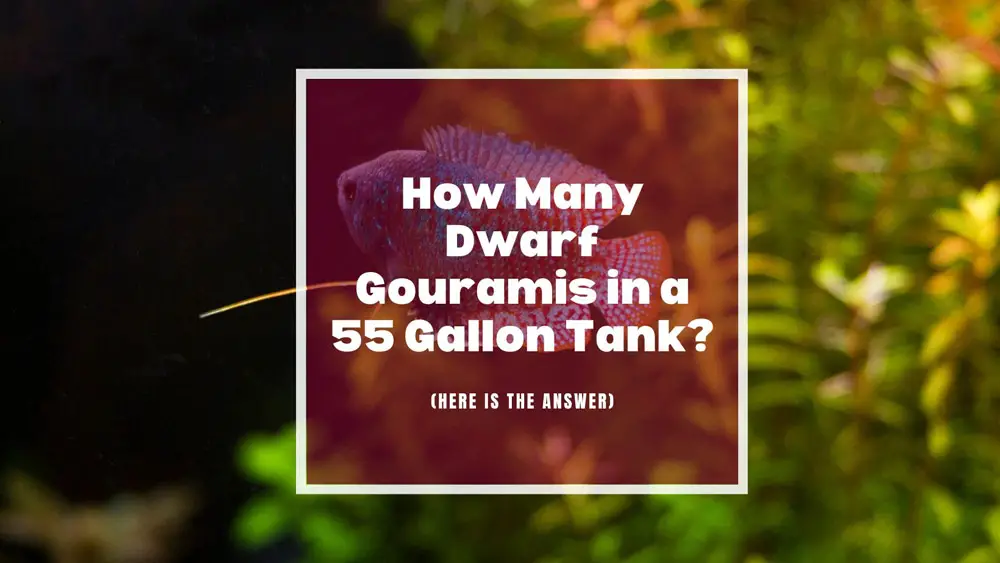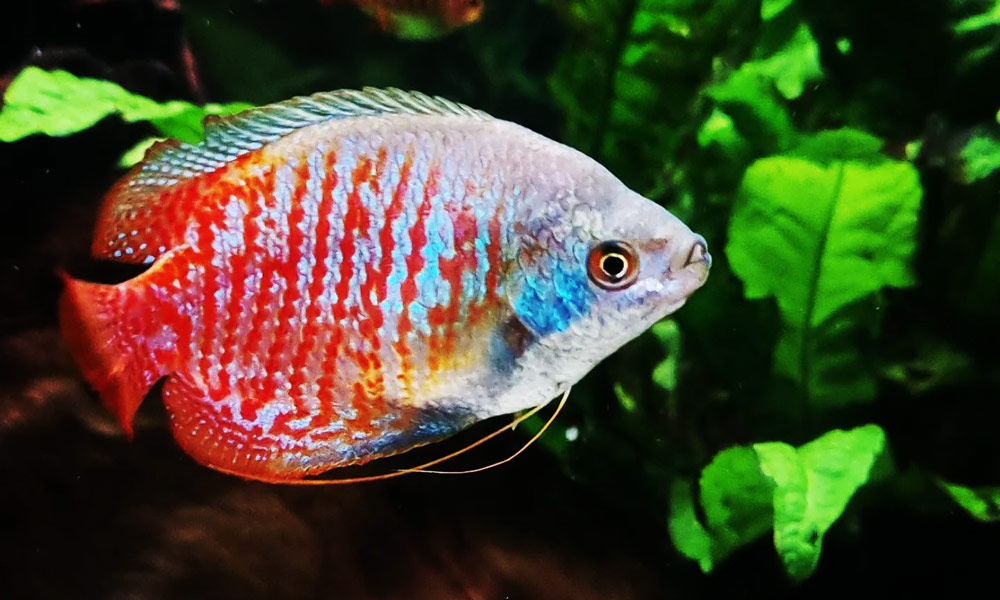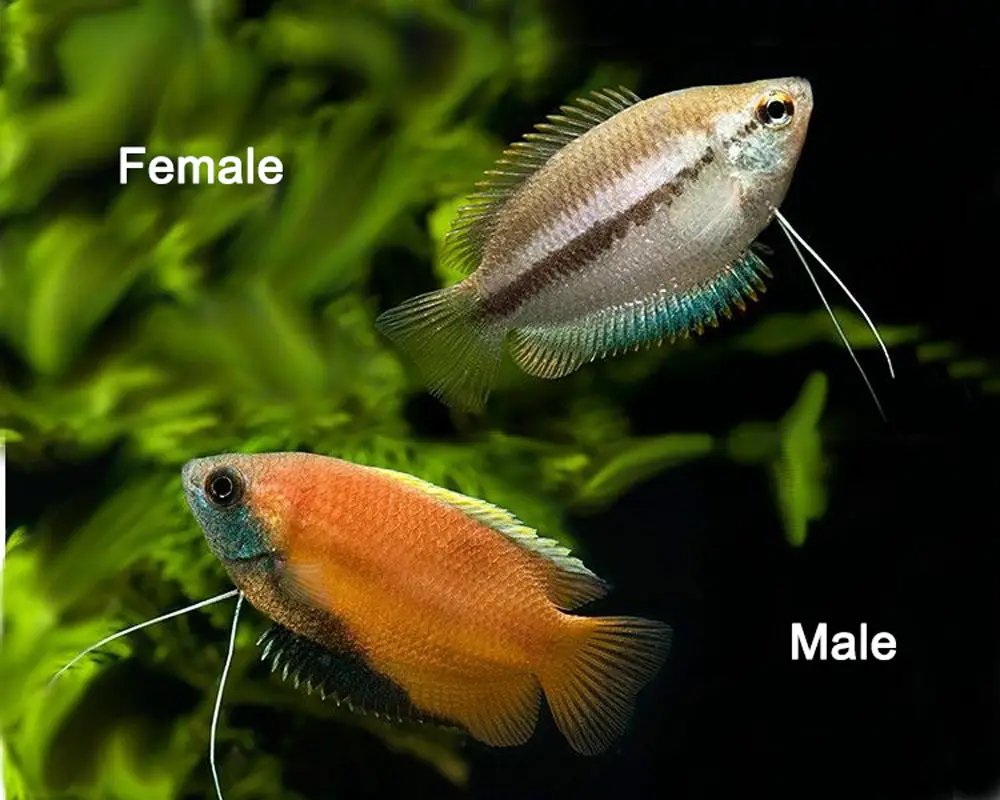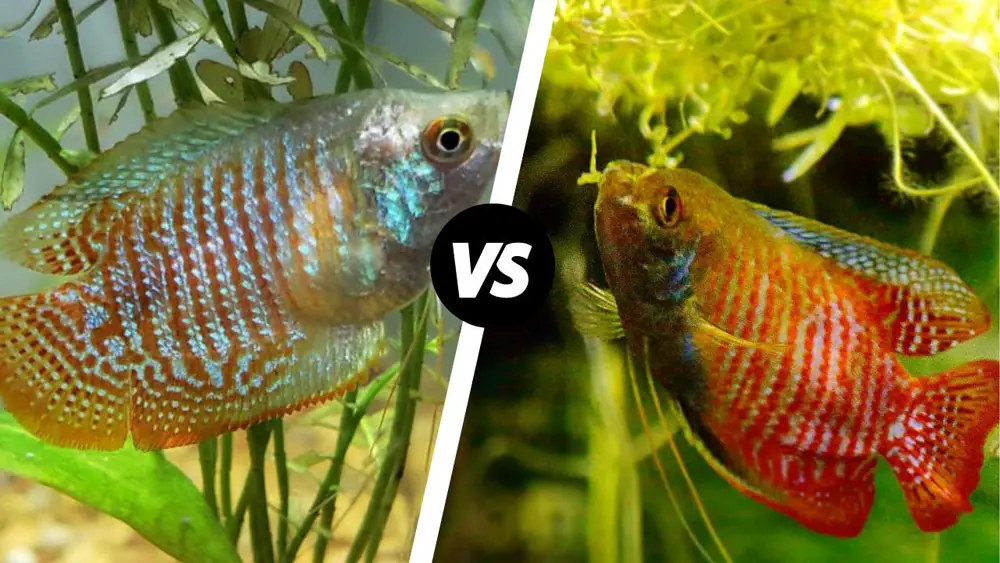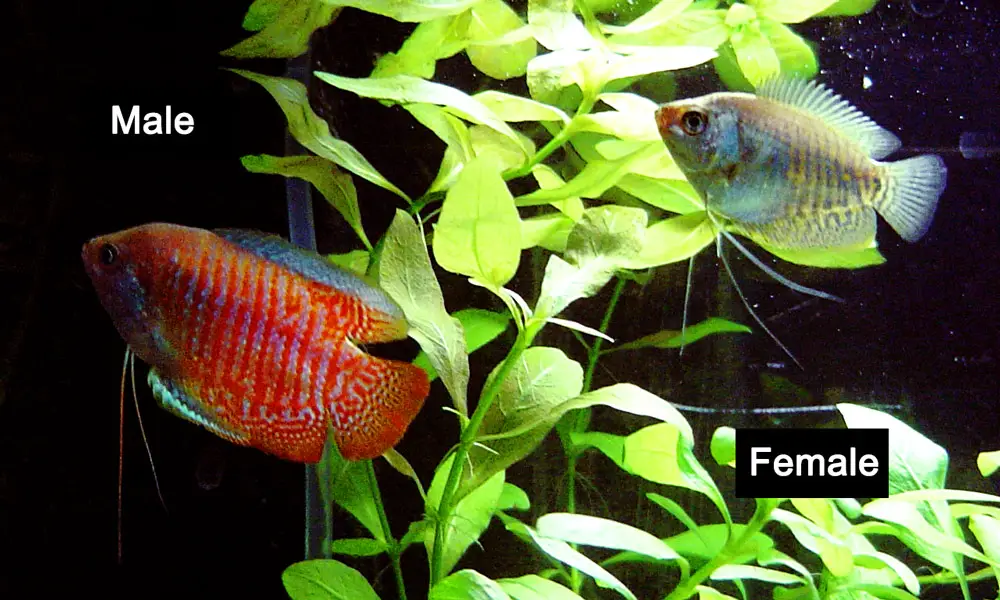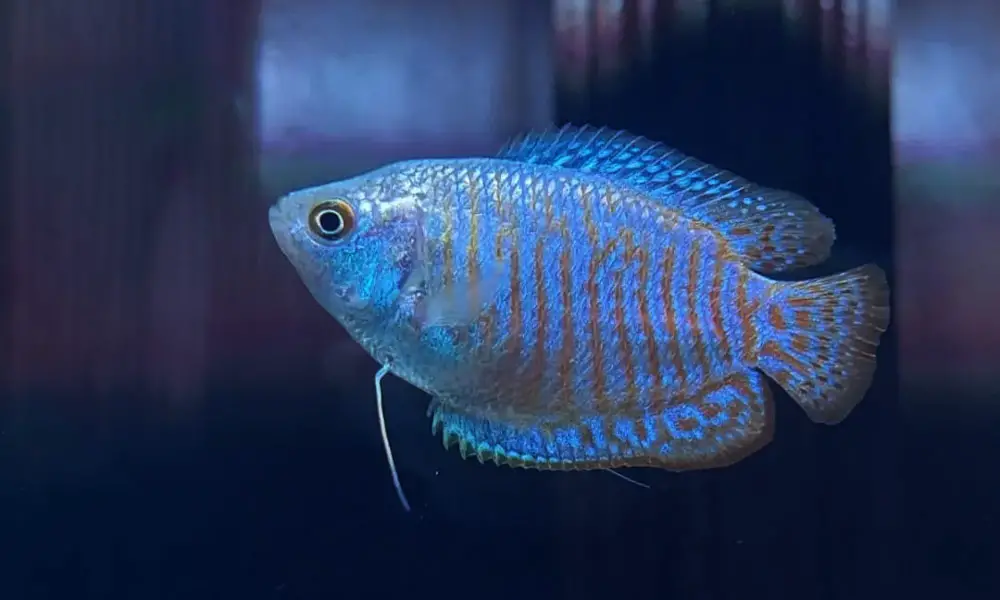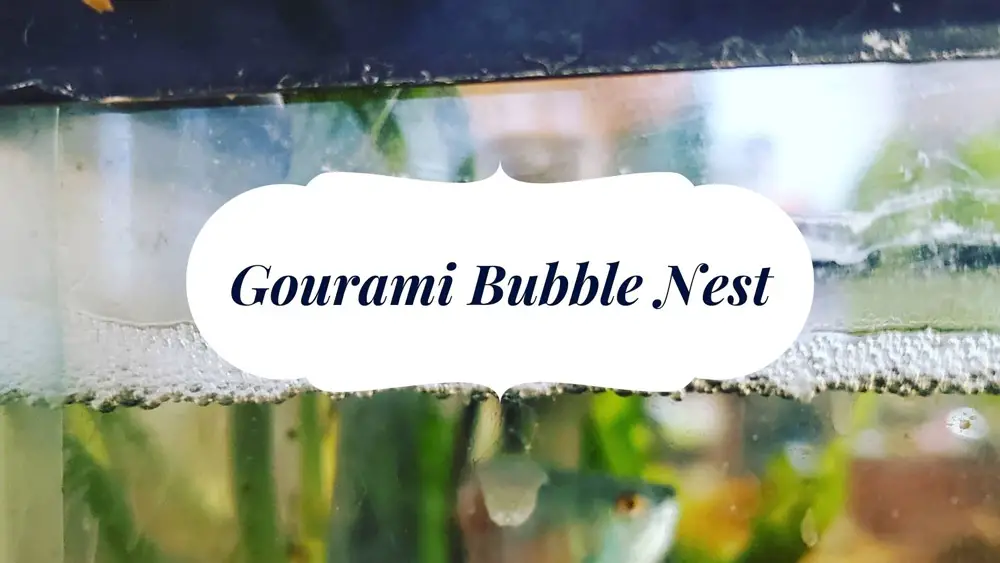The Neon Blue Dwarf Gourami is the most common and beloved color morph of Dwarf gouramis in the aquarium hobby.
Aside from their attractive appearance, these fish can also be peaceful and hardy, making them perfect for community tanks. To their credit, this fish is known to be very adaptable and fairly undemanding – enduringly has its place on any beginner’s wish list.
However, a study conducted in Australia in 2006 revealed that around 22% of the Dwarf Gouramis exported from Singapore fish farms carried the Dwarf gourami iridovirus (DGIV), a deadly virus caused by poor genetics. The Neon Blue Dwarf Gourami is also known to be susceptible to this virus.
As a result, it is important for owners to identify and choose healthy fish from retailers. Though it seems a little bit challenging, especially for beginner hobbyists, a little research can go a long way in improving the chance you’ll take home a new fish that will have a long and healthy life.
In this Neon Blue Dwarf Gourami care guide, we’ll cover everything you need to know about keeping these beautiful fish.
Breed Profile

The dwarf gourami (Trichogaster lalius) is a beautiful species of gourami native to Pakistan, northern India, and Bangladesh. However, it has been introduced into the aquarium trade and is now widely distributed throughout the world.
In the wild, male dwarf gouramis take on alternating blue and red colors, while females are usually drab in silvery color. Nowadays, breeders have created many color variations thanks to selectively bred. The Neon Blue Dwarf Gourami is a color morph developed to bring out more blue color than wild specimens, and it doesn’t exist in nature.
These fish are considered labyrinth fish, which means they have a lung-like labyrinth organ that allows them to get their oxygen straight from the surface.
Because of this, Neon Blue dwarf gourami spend a lot of time near the top or middle level of the aquarium. This is important to keep in mind when setting up their aquarium.
| Scientific Name: | Trichogaster lalius |
| Common Name: | Neon Blue Dwarf Gourami |
| Tank Level: | Top, mid-dweller |
| Care Level: | Easy |
| Origin: | Pakistan, northern India, and Bangladesh |
| Lifespan: | 4 – 6 years |
| Max Size: | 3.7 inches (9.5 cm) |
| Temperature: | 72 – 82°F (22 – 27°C) |
| PH: | 6.0 to 8.0 |
| Water hardness: | 10 to 20 dGH |
| Diet: | Omnivorous |
| Minimum Tank Size: | 10 gallons |
| Temperament: | Peaceful |
Size
For most ornamental fish breeds, selective breeding involves choosing and pairing specimens with particular colors to breed and produce offspring that inherit those desirable colors. This is how Neon Blue Dwarf gouramis are created.
Author note: Debate has increased over whether these color variations can quite match their natural brilliance.
Other than the more blue coloration, it doesn’t have other different physical traits from its wild relative, including the size. Thus, Neon Blue Dwarf Gouramis can reach a maximum length of about 3.7 inches (9.5 cm), but this is rare.
In most cases, they stay smaller in captivity, males tend to be a bit bigger than females, and they can grow to about 3 inches (7.5 cm) in length, while females only reach about 2.4 inches (6 cm).
Lifespan
As with most dwarf gouramis, the average Neon Blue dwarf gourami lifespan is between 4 and 6 years. Their lifespan can vary a bit depending on the quality of care they receive and whether there are genetic defects from the breeding strains.
To ensure your Neon Blue dwarf gourami has the best chance at a long and healthy life, it is important to provide them with high-quality food and a clean, well-maintained aquarium. What’s more, purchase your fish from a reputable source.
Appearance
There’s one reason for the popularity of Neon Blue Dwarf Gouramis that rises above the rest: their striking blue/turquoise coloration. Under the right conditions, their colors can be quite intense and breathtaking.
Unlike the Powder Blue morph that is covered in predominately blue color, Neon Blue Dwarf Gourami has a bright blueish color accented with bold vertical dark red stripes that run along their bodies. Because of this, they are sometimes referred to as the Rainbow Gourami, a different color variant.
These fish have a compressed and oval-shaped body with rounded and large fins. Their pelvic fins are filamentous and are covered with touch-sensitive cells to feel their way.
Males Vs. Females
Males are slightly larger than females and have a vivid orangish red base with turquoise vertical stripes extending onto the fins, while females have a more drab blue-gray body. Mature males develop elongated and pointed dorsal and anal fins. In females, these fins are shorter and much less pointed.
Care & Tank Setup
Since Neon Blue Dwarf Gourami has been domesticated for years, they have adapted well to living in captivity. Their small size, peaceful nature, and low maintenance make them the most beginner-friendly fish.
The lax care requirements can be managed by anyone with patience and time to spare. That said, they still require good water conditions and a little extra care to stay healthy and thrive.
Tank Size
Because of their small size, these fish don’t require you to possess a massive aquarium to keep them happy.
These small fish can be kept singly, in M/F pairs or trios (one male with two females) in a 10-gallon tank. If you have 4 or more fish with the ratio (M: F = 1: 2), you will need to provide a tank of at least 5 gallons per fish. As with all fish, it is important not to overcrowd the tank as this can lead to stress and illness.
Water Parameters
Dwarf Gouramis are a bit more hardy and adaptable than other fish. Well, they do have their preferred water chemistry.
Wild dwarf gouramis inhabit slow-moving streams and rivers that are heavily vegetated along with gentle water currents.
Try to recreate these water conditions closely in the home aquarium.
- Water temperature: 72 – 82°F (22 – 27°C)
- pH levels: 6.0 to 8.0
- Water hardness: 10 to 20 dGH
They prefer water temperatures a bit higher; as a result, the aquatic plants are free to flourish. Failure to keep these fish in the proper water conditions will damage their labyrinth organ, particularly the water temperature.
However, the warmer water is, the less oxygen it can hold. You will still need to provide neon blue rainbow gouramis with an aquarium that’s adequately ventilated to ensure they have enough oxygen even though they can gulp air from the surface. Meanwhile, their gills are more prone to burnout from dissolved ammonia.
Therefore, an efficient filtration system connected with an air stone is recommended. Not only will it help to make the filtration more efficient, but it will also fill the tank with oxygen.
Author note: If you’re trying to breed your Dwarf Gouramis on purpose, it’s important to have weaker water flow as it will likely destroy the bubble nest. Generally, a small air-driven sponge filter will work.
Decorate The Tank
As any tropical fish, Dwarf Gouramis prefer biotope setups that perfectly mimic their natural habitat.
Neon Blue Dwarf Gouramis will feel most at home in a densely planted aquarium with plenty of floating plants and tangles of plants as long as they can access the surface to breathe.
The floating plants are especially important in a breeding tank as the male often incorporates them to build his bubble nest. More than that, they can block intense light and are used to anchor the nests.
Most fish show their best colors on a dark substrate, and these colorful fish are no different. A dark substrate will really make their Neon blue color “pop.” Black backgrounds also provide a more natural setup to bring a splash of vibrant color to your aquarium.
It’s worth noting that this fish can be skittish by loud noises, so the tank should be placed in a quiet area.
Dwarf gourami Iridovirus (DGIV)
Dwarf gourami iridovirus (DGIV) is a fatal and highly contagious virus that affects all members of the gourami family. Originally thought to only affect Dwarf Gouramis, this disease has now been found in other species of gouramis as well.
The disease is characterized by lethargy, loss of appetite, loss of color, and bloated or swollen. In some cases, the fish may also display twitching muscles and erratic swimming.
There is no known cure and treatment for DGIV. Once symptoms appear, the fish will likely die within 1 day-6 months. The death rate of dwarf gourami reaches 100%.
Fortunately, there are some things you can do to help prevent your Neon Blue Dwarf Gourami from getting this disease.
- The best way to prevent your fish from contracting DGIV is to purchase them from a reputable dealer.
- Reject any gouramis from the tanks that already have sick or dead fish. Healthy Neon Blue dwarf gouramis are busy, active fish that should be swimming around the tank.
- Healthy dwarf gouramis will take any aquarium fare. You might want to ask the salesman to feed the fish on sale and look at their reaction. Unless you can explain any unusual behavior, don’t buy fish that seem weak and lose appetite.
- Dwarf gouramis that are displaying any of the aforementioned symptoms should be avoided at any cost.
- When you first get your dwarf gouramis home, do not put them straight into your display tank. Instead, set up a quarantine tank and observe them for at least three months. This will give you time to make sure they are not infected.
- The affected fish should be immediately removed from the tank to prevent the spread of the disease.
- Keeping them in a stress-free environment.
Food & Diet
When it comes to food, Neon Blue dwarf gouramis aren’t picky. They are omnivorous and accept most foods you provide in captivity.
These fish have no problem with an algae-based flake or pellet foods as their staple food. For optimal health and coloration, you should supplement their diet with periodic live/frozen meaty foods such as brine shrimp, daphnia, bloodworms, and mosquito larvae. Live foods should also be used to condition pairs for breeding.
Vegetable tablets or blanched vegetables such as zucchini, cucumber, and broccoli should also be given to them regularly. This will help ensure they are getting a good balance of nutrients.
Compatibility & Tank Mates
The Neon Blue dwarf gourami is usually peaceful and hardy and can be kept with other gentle fish that share their preferences and do not look similar.
Adult males can be territorial with each other, and subdominant males are often bullied. They should be kept one to a tank or in a group with at least two females per male. If you decide to keep more than one male, it’s best to have a larger tank with plenty of covers so they can each establish their own territory.
Also, do not house them with larger or more aggressive fish as they may become stressed and stop eating.
Here are some potential Neon Blue Dwarf Gourami tank mates:
- Peaceful cyprinids: Harlequin Rasbora
- Peaceful barbs: Cherry barbs, Gold barbs, Checkerboard barbs, and Pentazona barbs
- Small loaches: Kuhli Loach, Yoyo Loach, Zebra Loach
- Small catfish: Corys, Otocinclus
- Small tetras: Cardinal tetra, Neon tetra
- Dwarf rainbowfish (Melanotaenia praecox)
- Dwarf Cichlids: Golden Dwarf Cichlid(N. anomala), Checkerboard cichlid (C. punctulatum)
Breeding
Like wild dwarf gourami, breeding the neon blue dwarf gourami is not too difficult. We already have a whole post on gender differences and how to breed dwarf gouramis, so be sure to check that out if you want more information.
Wrapping Up
Neon Blue Dwarf Gouramis are a beautiful addition to any aquarium. They are relatively easy to care for if you provide them with a good diet and a stress-free environment.
When it comes to tank mates, these peaceful and hardy fish are well suited to most peaceful, small schooling fish.
All these unique characteristics, of course, presume you have healthy fish. Be sure to purchase your dwarf gouramis from a reputable dealer and always quarantine new fish before adding them to your tank.
If you have any questions or stories about this pretty fish, we’d love to hear from you.
Good luck!
